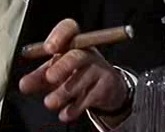Former U.S. President Franklin D. Roosevelt Could Have Been Saved from Death at Age 63
Pres. Franklin D. Roosevelt smoked cigarette and cigar

Former U.S. President F.D. Roosevelt succumbed to free radicals and radiation produced by his cigarettes.
By Conrado D. Fontanilla
President Franklin Delano Roosevelt with Prime Minister Winston Churchill of Great Britain, and Marshall Joseph Stalin of the Soviet Union lead the Allies in World War II against the Axis powers, Italy, Japan and Germany.
Roosevelt never took to the battlefield but he was killed during the war by enemies within (apologies to former senator Robert F. Kennedy who wrote a book “Enemies Within").
These enemies were free radicals, radiation and stress.
Free radicals and Radiation, the invisible enemies
The Big Three of the Allies (Roosevelt, Churchill and Stalin) had just concluded a conference in Tehran, Iran toward the end of 1943.
“On his return to the U.S. from Tehran, Roosevelt complained of headaches and flu symptoms..... By January 1944, he had made a little improvement, and began visiting Hyde Park each weekend in an effort to regain his health. In March, he went for a check-up at the Bethesda Naval Hospital in Maryland, Virginia. The doctors found that his arteries were closing up and that he was in danger of suffering a heart attack. Roosevelt was ordered to get more rest and cut down on his smoking, but the American people was not informed of his condition....” Taylor, D. Franklin D. Roosevelt. 2002:42).
Roosevelt smoked cigar and cigarettes. Much earlier, Roosevelt’s arteries, most probably aorta and heart arteries, had grown occlusions. The doctors’ warning came too late. Five years later the hazards of smoking were confirmed..
“In the 1950s and '60s research produced medical evidence that linked cigarette smoking with health hazards, especially with lung cancer, emphysema, and heart disease” (Microsoft Encarta encyclopedia 2009).
Radioactive materials in tobacco
Tobacco is an accumulator of polonium 210 and lead 210 that are radioactive (Microsoft Encarta 2009). That is, it absorbs these semi-metals from the soil in excess amount, whether it needs them or not. These are concentrated on the leaves.
The tobacco plant gets these radioactive materials from the fertilizer applied in growing it (Cranton, E., MD and A. Brecher. Bypassing Bypass. 184:160). Even in the absence of fertilizer, these metals are available in the air.
Radiation, mutation, cancer
A radioactive material is unstable. To attain stability it goes through decay called tunneling. The radioactive polonium 210 emits alpha particles and alpha radiation, a form of energy. Alpha particles tunnel through the nucleus, a barrier. Radiation hits tissues like the DNA, the heredity material. DNA has a lot of hydrogen that consists of one proton and one electron. The hydrogen bond (like in water) joins the bases of DNA together but the joints are weak. Hydrogen has no nucleus so it is all the easier for radiation to hit its elements, according to Gerald Tortora and associate in their book “Life Science.”
In the hydrogen bond, there is a potential energy barrier. In both sides of this barrier are potential wells. One is shallower than the other. The proton normally settles on the deeper well. However, it can tunnel to the shallower well when hit by radiation. When replication of DNA occurs while the proton is at the shallower well, the pairing between bases of DNA is compromised (lenntech.com. Aug. 26,2014)
An error in copying of the original pairing occurs, results in mutation in DNA that can result further in tumor or cancer.
“The bases of DNA are the parts that hold the key to inheritance. The four bases are adenine (A), thymine (T), guanine (G), and cytosine (C). In the two strands of DNA, A is always complementary to (pairs with) T, and G is always complementary to C...During mitosis, the chromosomes are replicated by the unwinding and pulling apart (splitting) of the DNA strands, a new strand is formed alongside the old. The old strand serves as a template so that wherever an A occurs on the old strand, a T will be directly opposite it on the new, and wherever a C occurs on the old strand, a G will be placed on the new. Complementary bases pair with each other until two entire double-stranded molecules are formed where originally there was one” (Taylor T. E. and T. G. Field. Scientific Farm Animal Production. 1998:219-220, parenthetical supplied)
The hydrogen bond in the chromosomes are vulnerable to radiation during the splitting of duplicates. Copying error occurs.
Polonium 210, with 84 protons, decays and stabilizes at polonium 206, with 82 protons. A proton is paired with an electron. There is a loss of two protons during alpha decay leaving two unpaired electrons. These unpaired electrons make for free radicals that are unstable. To stabilize itself, a free radical grabs one or two electrons from a neighboring molecule like DNA. This grabbing results in mutation of DNA, that, in turn, results in tumor or cancer.
So radiation and free radicals from the decay of polonium 210 may result in mutation of DNA that may result in tumor or cancer.
If you stopped smoking now you had already ingested lead 210 that will supply polonium 210 for at least 22.5 years more.
President F.D. Roosevelt suffered a hemorrhagic stroke
Polonium 210 had accumulated in the tissues of President F.D. Roosevelt and the orphaned electrons had been marauding for other electrons in his tissues. President F.D. Roosevelt having had a heart condition means that at least one artery in his heart had an occlusion. He suffered from hemorrhagic stroke which means that a major artery supplying blood to his brain had an occlusion or aneurysm. Occlusion or aneurysm started as injuries caused by free radicals. An injury in the inside wall of heart artery results in benign tumor called atheroma. As a repair mechanism, it gathers collagen, elastin, fibrin, and other debris. Calcium comes in later. This combination grows into a mound then occlusion (Cranton, E., MD and A. Brecher. Bypassing Bypass. 1984). Free radicals also damage the middle layer of an artery resulting in arteriosclerosis.
A free radical is any atom or ion or molecule or fragment of a molecule with at least one unpaired electron in its outermost orbital. That electron is unstable and to attain stability it grabs another electron from a neighboring molecule, which is usually a part of a tissue or organ. The victim of grabbing is injured; that injury results in mutation of the chromosome that is shown as tumor or cancer. Examples of free radicals are atomic oxygen, molecular oxygen, ozone, superoxide, singlet oxygen, and reactive oxygen species (ROS) like hydrogen peroxide, nitrosamine, hydroxyl, LDL-ox, lipid peroxy radical, nitrobenzene, diethylstilbestrol, carbon tetrachloride, and many more. ROS are not technically free radicals but they behave like free radicals do.
Sometimes, the artery becomes weak due to arteriosclerosis and forms a pouch or a bulge that can easily rapture (DeBakey, M., MD and A. Gotto, MD. The New Living Heart. 1997).
The hemorrhagic stroke of President Roosevelt consisted of an artery bursting and blood spreading into the brain. The brain was starved for oxygen; the starvation was fatal. I have not read a report on whether it was an aneurysm or an occluded artery that burst in President Roosevelt’s case. But the fact is that President F.D. Roosevelt died of hemorrhagic stroke.
Untreated deterioration
“People close to him (Roosevelt), however, could not help but notice the bags under his eyes, his grey complexion, and his failing memory” (Taylor, D., Franklin D. Roosevelt. 2002:42).
The Big Three had another conference at Yalta in the Crimea that started on February 4,1945. Germany was already on the verge of defeat and the conference decided on the fate of the world after the war.
“On his return to Washington, Roosevelt addressed Congress on March 1,1945. He looked frail and tired. Senators and congressmen who had not seen him for a while were taken aback by the way he looked, and many were convinced that they would not see him alive again....” (Taylor, D., Franklin D. Roosevelt. 2002:49).
He decided to take a retreat in Georgia, at the National Foundation for Infantile Paralysis. A children's show had been prepared for the President. A Filipino chef had prepared one of his favorite dish. Before the show, he sat for a portrait painting (Kluger, J. Splendid Solution, Jonas Salk and the Conquest of Polio. 2004:70).
“At midday on Thursday, April 12, Elizabeth Shoumatoff arrived to continue the portrait she was painting of the president. At about 1:15 P.M. as he was sitting for the artist, Roosevelt complained of a ‘terrible headache’ and slouched forward in his chair. His two doctors were immediately called. The president "had suffered a massive cerebral hemorrhage." He was taken to his bedroom unconscious and, despite being given artificial respiration, was pronounced dead at 3:25 P.M.” (Taylor, D. Franklin D. Roosevelt. 2002:50). He was aged 63, still young. (Ronald Reagan became US president when he was 70 years old.)
Hitler committed suicide on April 30,1945. Hitler's Germany surrendered on May 7,1945. Japan surrendered on August 10,1945, considered as the end of WWII. Although he did not live to see the victory of the Allied Powers over the Axis Powers, Roosevelt had largely helped nurture that victory.
Technologies that could have benefited Roosevelt
If two-dimensional echocardiography and angiography or magnetic resonance imaging had been around when the president was still alive, he could have been diagnosed for occlusion in an artery. In addition, if infusion chelation therapy (developed after World War II) had been in use his blockage could have been dissolved. The development of his hemorrhagic stroke could have been prevented with 45 to 60 sessions of infusion chelation therapy. Cardiovascular technology was still lacking in 1945 that attending doctors helplessly watched Roosevelt die.
Such was the state of medical knowledge then. "This type of brain burst was wholly untreatable, and the doctor could do little more than sit with the stricken Roosevelt for nearly two hours, watching as his breath grew weaker, his color grew purplish, and his skin grew cold" (Kluger, J. Splendid Solution, Jonas Salk and the Conquest of Polio. 2004:70).
Today, Roosevelt could have been scanned and injected with a drug like streptokinase to dissolve blood clot. The new recombinant tissue plasminogen activator, or t-PA, more effective than streptokinase by two percent, is now in use (Anders, G. Health Against Wealth. 1996:106). Two hours is a long time, and depending on the extent of the stroke that struck him, he could still survive.
Stress
Stress triggers the body to go into a mode of fight or flight that require extra energy (Sharma, H., MD. Freedom from Disease (How to control free radicals, a major cause of aging and Disease). 1993:65-67]. “Constant stress generates a constant flow of free radicals” according to Sharma.
Stress-related chemicals like cortisol, catecholamine, epinephrine, and norepinephrine “lead to the creation of leukotrienes and thromboxanes” that create free radicals.
“This chemical pathway systematically produces free radicals as toxic waste. Even worse, catecholamines themselves breakdown into free radicals, and some into free radical factories….” (Sharma, same source as above).
“Leukotrienes are potent inflammatory substances that attract white blood cells to the area which produce free radicals as bullets to attack foreign invaders” (Cranton, E., M.D. and A. Brecher. Bypassing Bypass. 1984:69). Extra stimulation by leukotrienes triggers white blood cells to produce extra amount of free radicals “which cause increasing inflammatory damage to healthy tissue.” Small blood cells expand, shown as swelling and edema.
Thromboxane is a hormone that causes extreme spasm in blood vessels and aggregation of blood platelets resulting in clot. Spasm may result in decreased blood flow or hypertension, if it is already compromised by atherosclerosis.
Cortisol is a hormone that elevates blood sugar, promotes salt and fluid retention (edema), and depresses inflammatory and immune response. Catecholamine is a hormone that increases heart rate and blood pressure, and speeds up metabolism (Brody, H., M.D., Ph.D. The Placebo Response, 1997:117-118).
Stressful situations
Throughout his presidency, Roosevelt had been confronted with stressful situations. In fact, he won the presidency on the confidence on him that he could solve the Great Depression of 1929. His first act was to declare a bank holiday, assess the banking system and opened banks worthy of trust.
Next was the creation of jobs through employment with the government. Thus the creation of alphabet agencies like Public Works Administration and Civilian Conservation Corps. He set up the atmosphere for good business practices. He came to the aid of farmers and set up the Tennessee Valley Authority which was threatened with being unconstitutional by the Supreme Court. Whereupon Roosevelt embarked to increase the membership of the Supreme Court from 9 to 15 in the hope that the court would be receptive to his New Deal measures. He failed, and got a lot of criticisms for attempting to pack the court.
When Europe largely went under the thumbs of Hitler, Roosevelt had to contend with the American isolationists who wanted to keep out of the European war. He wanted the United States to help Great Britain. The Japanese surprise attack at Pearl Harbor made Roosevelt’s path to coming to the aid of democracy.
Unemployment was not successfully remedied until the coming of World War II which needed a lot of hands to manufacture munitions of war.
In 1921 yet Roosevelt, at age 39, was afflicted with a personal source of stress. He contracted polio and was paralyzed from the waist down. Swimming was his form of exercise. He sought to cure his wasted legs with the waters of Warm Springs in Georgia which he later proclaimed as National Foundation for Infantile Paralysis to also serve as a center for the rehabilitation of polio victims. He told jokes of his limp legs. He could climb a stairway backwards. He sat on one tread and raised his body to the next with his strong arms.Stamp collection was his hobby.
Pres. F.D. Roosevelt was elected to four terms ((March1933 to April 1945) as president of the United States. He did not complete his last term when he died in April 1945 at age 63 from the ravages of free radicals and X-rays.
New entries as of May 30,2014
The National Institutes of Health (National Institute of Heart, Lungs and Blood) of the United States conducted a study called "Trials to Assess Chelation Therapy" (TACT) that was launched in 2002. It is a double blind randomized with control study that costs $ 30 million. TACT found that chelation therapy is safe and effective for the treatment of heart disease. It also found to be safe and effective for the treatment of diabetes. This is an incidental finding. It so happened that some of the participants in TACT had diabetes. At the end of treatment, they also got well of their diabetes.
Results of TACT were presented at a meeting of the American Heart Association on November 4,2012 in Los Angeles, California.
I have another Hub, "USA announced chelation therapy as safe and effective for heart disease and diabetes."
Chelation therapy also treats stroke. Dr. Arturo V. Estuita, MD, a Filipino internist and chelationist had revived a fellow who had been in coma for one week owing to hemorrhagic stroke. A high official of an investigating agency, National Bureau of Investigation of the Philippines, the patient is now back to work. Chelation therapy dissolves blood clot, erodes plaque of artery and widens the artery, according to Dr. Estuita who had specialized in chelation in USA.





